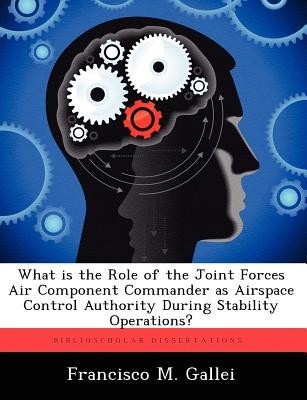
- We will send in 10–14 business days.
- Author: Francisco M Gallei
- Publisher: BiblioScholar
- ISBN-10: 1249440343
- ISBN-13: 9781249440345
- Format: 18.9 x 24.6 x 0.6 cm, softcover
- Language: English
- SAVE -10% with code: EXTRA
What Is the Role of the Joint Forces Air Component Commander as Airspace Control Authority During Stability Operations? (e-book) (used book) | bookbook.eu
Reviews
Description
Airspace control is not a new concept and there has been considerable doctrinal development and discussion over the last 50 years. However, the role the joint forces air component commander as the airspace control authority during stability operations has not been explored. Airspace control has become increasingly complex due to the increase of unmanned aerial vehicles in use by the Army and other services. Differences in airspace control capability, the lack airspace control equipment, doctrine, joint training and common systems increase the difficulties for the joint forces air component commander to function as airspace control authority during stability operations. This analysis highlights the robust air control system employed during stability operations (counterinsurgency) in South Vietnam, but was not available for Operation Enduring Freedom and for Operation Iraqi Freedom after major combat operations ended and stability operations began. This study specifically highlights the lack of certain items of air control equipment, airspace control doctrine for stability operations, common systems, and robust joint training and offers recommendations for improving joint capabilities and doctrine.
EXTRA 10 % discount with code: EXTRA
The promotion ends in 17d.06:30:32
The discount code is valid when purchasing from 10 €. Discounts do not stack.
- Author: Francisco M Gallei
- Publisher: BiblioScholar
- ISBN-10: 1249440343
- ISBN-13: 9781249440345
- Format: 18.9 x 24.6 x 0.6 cm, softcover
- Language: English English
Airspace control is not a new concept and there has been considerable doctrinal development and discussion over the last 50 years. However, the role the joint forces air component commander as the airspace control authority during stability operations has not been explored. Airspace control has become increasingly complex due to the increase of unmanned aerial vehicles in use by the Army and other services. Differences in airspace control capability, the lack airspace control equipment, doctrine, joint training and common systems increase the difficulties for the joint forces air component commander to function as airspace control authority during stability operations. This analysis highlights the robust air control system employed during stability operations (counterinsurgency) in South Vietnam, but was not available for Operation Enduring Freedom and for Operation Iraqi Freedom after major combat operations ended and stability operations began. This study specifically highlights the lack of certain items of air control equipment, airspace control doctrine for stability operations, common systems, and robust joint training and offers recommendations for improving joint capabilities and doctrine.


Reviews